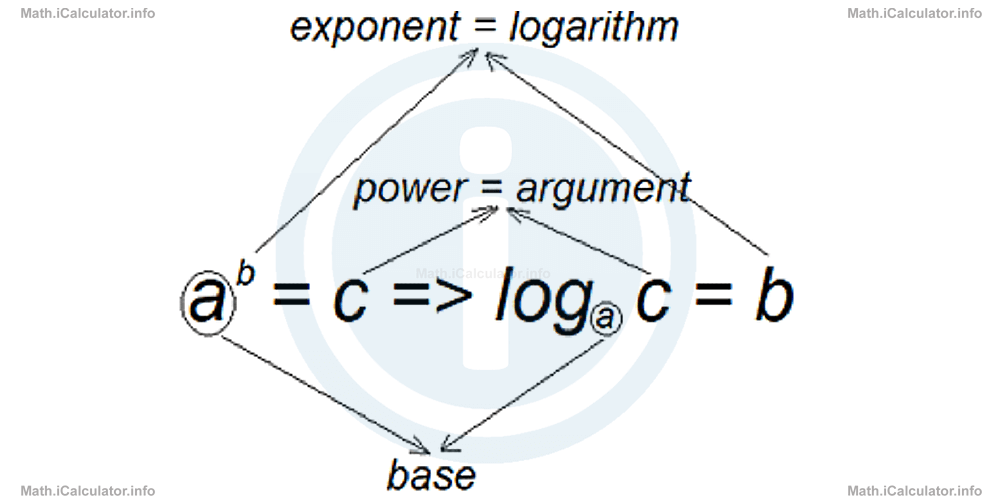Menu
Math Lesson 13.1.1 - The Definition of Logarithm
Please provide a rating, it takes seconds and helps us to keep this resource free for all to use
Welcome to our Math lesson on The Definition of Logarithm, this is the first lesson of our suite of math lessons covering the topic of Definition and Properties of Logarithms, you can find links to the other lessons within this tutorial and access additional Math learning resources below this lesson.
The Definition of Logarithm
Let's consider again the exponential expressionwhere a is called the 'base', b is called the 'exponent' (or 'index') and c is the result of the operation called 'power'.
For example, in the numerical sentence
the base is 3, the exponent is 2 and the power is 9.
When dealing with indices in tutorial 7.1, we explained that exponents were invented to make the multiplication of the same factors easier and shorter. Thus, instead of writing
we write
where the exponent 5 shows how many times the same factor 2 (i.e. the base) is multiplied by itself to give the product (power) 32.
If the base a and the power c are known and we want to express the base b in terms of them, we write the expression
in a new form, i.e.
This operation is called a logarithm ("log" is an abbreviation for "logarithm"). Thus, a logarithm represents another way of expressing the exponential form of a number, where the variable to be found is the exponent, not the power.
The terms included in a logarithm are as follows:
The term 'a' is still called the base, like in the corresponding exponential form;
The term 'b' is called the logarithm, unlike in the corresponding exponential form, where it is called the 'exponent'.
The term 'c' is called the 'argument', unlike in the corresponding exponential for, where it was called the 'power'.

We read this new expression as "the logarithm with base a of c is b", or simply "log base a of c is b".
Example 1
Write the following mathematical sentences as logarithms.
- 35 = 243
- 27 = 128
- 134 = 1
Solution 1
- We have the following terms involved in the operation 35 = 243: 3 → baseFrom theory, it is known that when converting an exponential expression into a logarithmic one, we have the following equivalences:
5 → exponent
243 → powerBase of the exponential form = base of the logarithmic formHence, we obtain for the logarithmic form of the given mathematical sentence:
Power of the exponential form = argument of the logarithmic form
Exponent = logarithm3→ baseIn this way, we obtain
5→ logarithm
→ argument35 = 243 = > log3 243 = 5 - We have the following terms involved in the operation 27 = 128: 2 → baseFrom theory, it is known that when converting an exponential expression into a logarithmic one, we have the following equivalences:
7 → exponent
128 → powerBase of the exponential form = base of the logarithmic formHence, we obtain for the logarithmic form of the given mathematical sentence:
Power of the exponential form = argument of the logarithmic form
Exponent = logarithm2→ baseIn this way, we obtain
7→ logarithm
128→ argument27 = 128 = > log2 128 = 7 - We have the following terms involved in the operation 134 = 1: 1 → baseFrom theory, it is known that when converting an exponential expression into a logarithmic one, we have the following equivalences:
34 → exponent
1→ powerBase of the exponential form = base of the logarithmic formHence, we obtain for the logarithmic form of the given mathematical sentence:
Power of the exponential form = argument of the logarithmic form
Exponent = logarithm1→ baseIn this way, we obtain
1→ logarithm
34→ argument134 = 1 = > log1 1 = 34
Remark! If the base of a logarithm is not written, it is taken as 10. This means the notations log10 x and log x are equivalent.
More Definition and Properties of Logarithms Lessons and Learning Resources
Whats next?
Enjoy the "The Definition of Logarithm" math lesson? People who liked the "Definition and Properties of Logarithms lesson found the following resources useful:
- Definition Feedback. Helps other - Leave a rating for this definition (see below)
- Logarithms Math tutorial: Definition and Properties of Logarithms. Read the Definition and Properties of Logarithms math tutorial and build your math knowledge of Logarithms
- Logarithms Video tutorial: Definition and Properties of Logarithms. Watch or listen to the Definition and Properties of Logarithms video tutorial, a useful way to help you revise when travelling to and from school/college
- Logarithms Revision Notes: Definition and Properties of Logarithms. Print the notes so you can revise the key points covered in the math tutorial for Definition and Properties of Logarithms
- Logarithms Practice Questions: Definition and Properties of Logarithms. Test and improve your knowledge of Definition and Properties of Logarithms with example questins and answers
- Check your calculations for Logarithms questions with our excellent Logarithms calculators which contain full equations and calculations clearly displayed line by line. See the Logarithms Calculators by iCalculator™ below.
- Continuing learning logarithms - read our next math tutorial: Exponential and Logarithmic Equations
Help others Learning Math just like you
Please provide a rating, it takes seconds and helps us to keep this resource free for all to use
We hope you found this Math tutorial "Definition and Properties of Logarithms" useful. If you did it would be great if you could spare the time to rate this math tutorial (simply click on the number of stars that match your assessment of this math learning aide) and/or share on social media, this helps us identify popular tutorials and calculators and expand our free learning resources to support our users around the world have free access to expand their knowledge of math and other disciplines.